Returning to the workplace
When reopening premises to staff, employers must plan properly and consider the health and wellbeing of all involved.
As of September 2021, the Government is no longer instructing people to work from home if they can, and is expecting workers to gradually return to workplaces and business premises. However, businesses are still free to decide between continuing with home-working or reopening premises with COVID-secure measures in place.
But because many employees will be anxious about their safety, it's vital that employers consult them at every turn and make decisions based on what's best for their physical and mental health.
Official government guidance
Working safely during COVID-19
The Government has practical advice for businesses that are returning to the workplace. This includes priority actions to take to help protect staff and customers, including:
- completing a risk assessment
- providing adequate ventilation
- developing cleaning, hand-washing and hygiene procedures
- turning away people with COVID-19 symptoms
- allowing people to check in via NHS Test and Trace
- keeping workers, contractors and visitors up-to-date on how you're using and updating safety measures
Read the Government’s guidance on working safely during coronavirus
Guidance for specific types of business
As there are many different businesses and workplaces reopening after lockdown, the Government has created guides for various industries and sectors. These include:
- close-contact services (e.g. hairdressers, beauticians, tattooists)
- construction and other outdoor work
- factories, plants and warehouses
- hotels and other guest accommodation
- labs and research facilities
- offices and contact centres
- restaurants, pubs, bars and takeaway services
- shops
Use the guide most relevant to your business and follow it to help keep your workers safe.
Making your workplace COVID-secure
A COVID-secure workplace is one which is as safe as possible for staff, visitors, tradespeople and anyone else who might spend time there during coronavirus.
Read more in our guide to making your workplace COVID-secure. For now, you can follow the steps below to help make sure your premises are safe.
Assess the risks
Before you allow workers to return, you must:
- carry out a risk assessment
- put measures in place to stop any risks from occurring
A risk assessment identifies and evaluates possible hazards in the workplace. The measures you implement to prevent those hazards causing harm will likely include:
- hand-washing, cleaning and hygiene routines
- staggered working hours
- making sure there is proper ventilation
The Federation of Small Businesses (FSB) has step-by-step advice on how to carry out a workplace risk assessment.
Introduce hand-washing, cleaning and hygiene procedures
Making a workplace COVID-secure means putting in place strict procedures around hand-washing and cleaning, and encouraging people to follow them.
Read the Government’s guidance on cleaning, hand-washing and hygiene
These procedures include:
- making hand sanitiser available around the building
- regularly cleaning and disinfecting objects and surfaces that people often touch
- setting clear use and cleaning guidance for toilets
Bringing employees back to the workplace
You'll have been in close contact with your employees throughout COVID-19. As you manage their return to the workplace, it's crucial that you maintain this level of communication and keep everyone up to date with what you're planning to do.
Health and safety measures
Tell your employees about the risk assessment you've conducted and the measures you've put in place to ensure their safety when they come back.
By law, you must consult your workforce about any new health and safety procedures you've introduced.
Reorientation
As part of the return-to-work process, managers should meet with the employees on their teams to discuss health, safety and wellbeing and what adjustments might be needed to help people settle back in.
This will be particularly important for employees who have been furloughed for long periods.
Staff who are reluctant or unwilling to return
It's understandable that some people will be apprehensive about going back to the workplace. As their employer, you should listen to their concerns and take whatever steps you can to alleviate their worries.
Disclaimer: We make reasonable efforts to keep the content of this article up to date, but we do not guarantee or warrant (implied or otherwise) that it is current, accurate or complete. This article is intended for general information purposes only and does not constitute advice of any kind, including legal, financial, tax, or other professional advice. You should always seek professional or specialist advice or support before doing anything on the basis of the content of this article.
Neither British Business Bank plc nor any of its subsidiaries are liable for any loss or damage (foreseeable or not) that may come from relying on this article, whether as result of our negligence, breach of contract or otherwise. “Loss” includes (but is not limited to) any direct, indirect, or consequential loss, loss of income, revenue, benefits, profits, opportunity, anticipated savings, or data. We do not exclude liability for any liability which cannot be excluded or limited under English law.
Tags related to this content:

Making business finance work for you: Expanded edition
Our Making business finance work for you: Expanded edition is designed to help you make an informed choice about accessing the right type of finance for you and your business.



